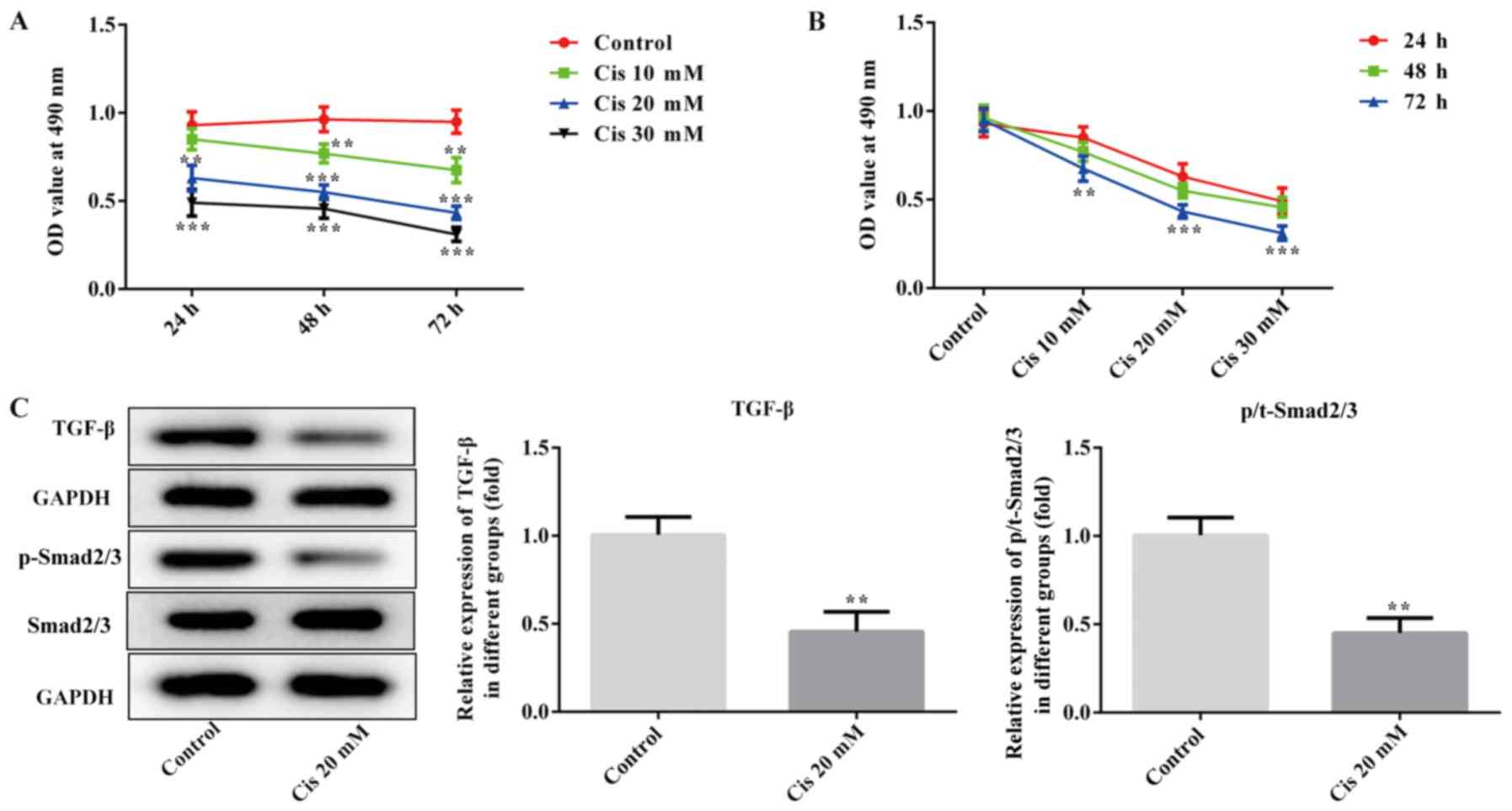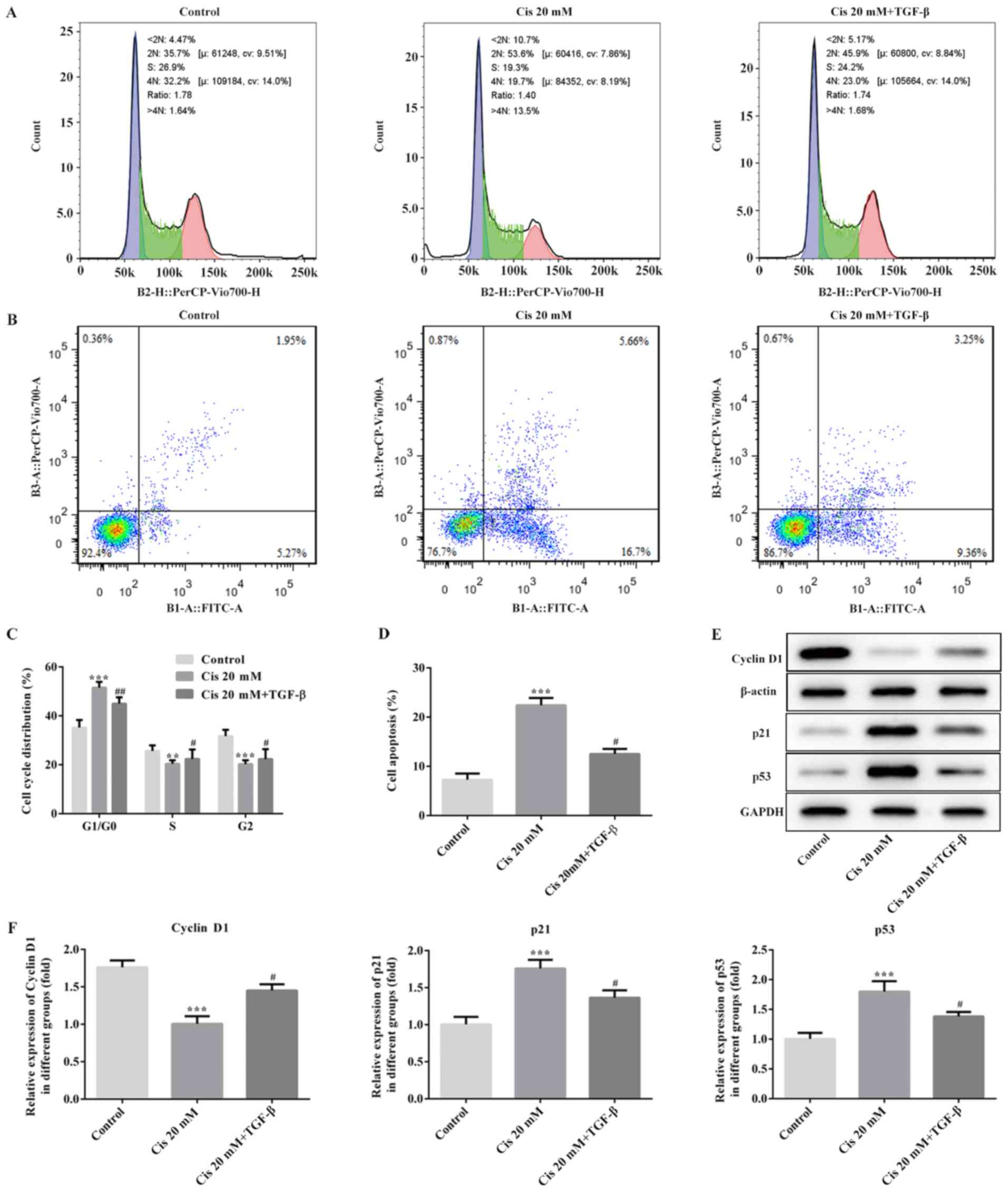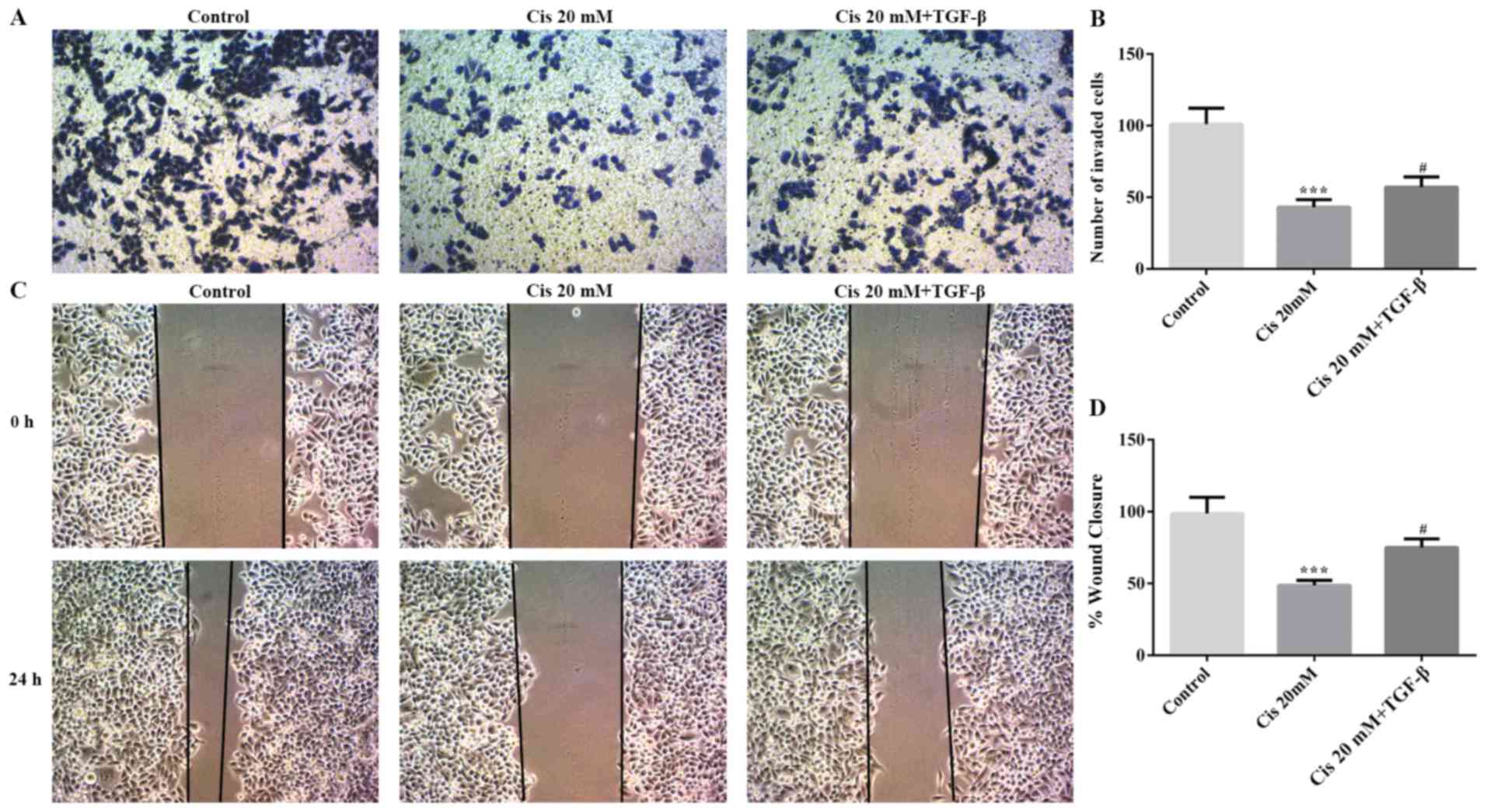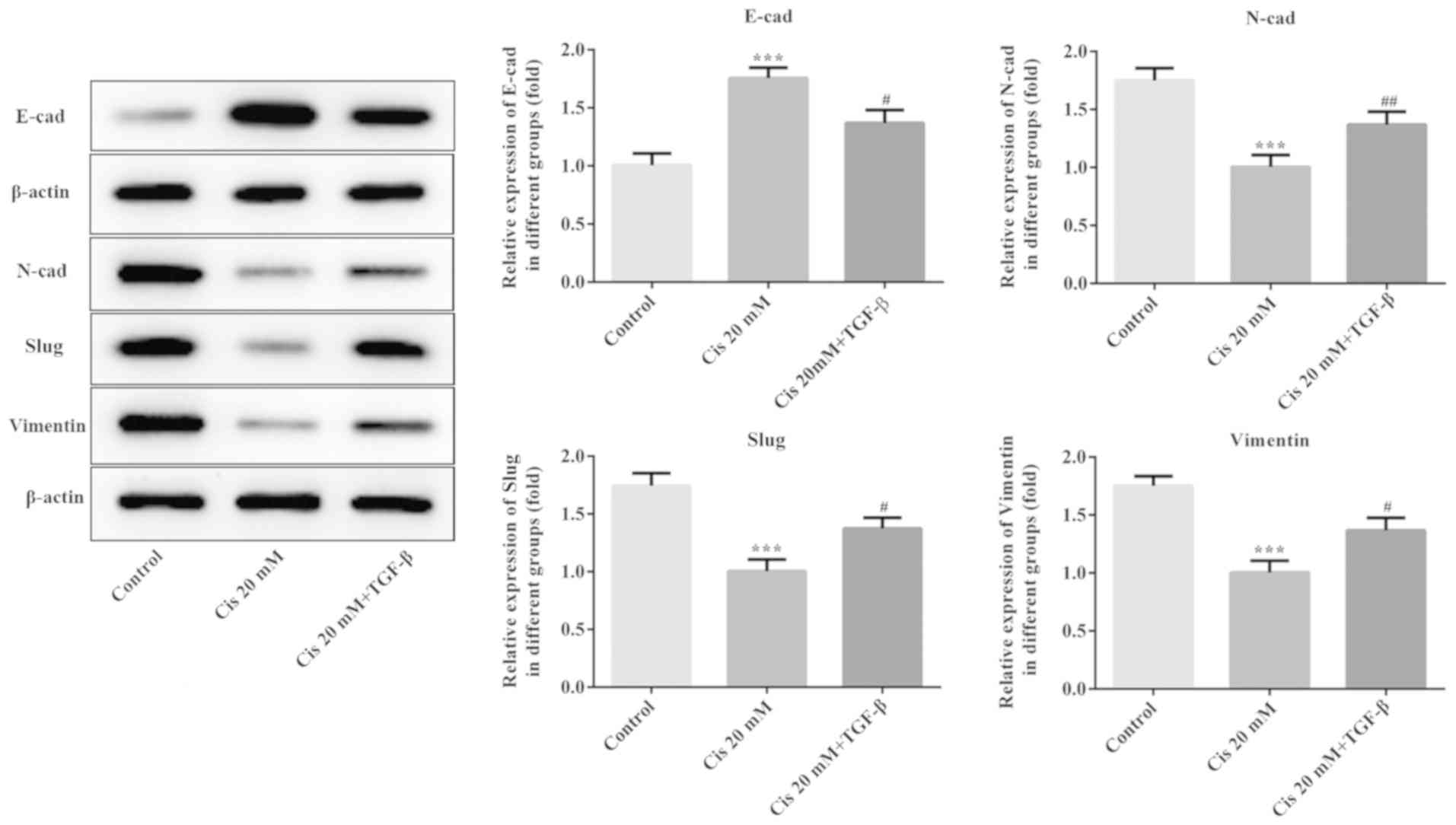|
1
|
Siegel RL, Miller KD and Jemal A: Cancer
statistics, 2018. CA Cancer J Clin. 68:7–30. 2018. View Article : Google Scholar : PubMed/NCBI
|
|
2
|
Chen W, Zheng R, Baade PD, Zhang S, Zeng
H, Bray F, Jemal A, Yu XQ and He J: Cancer statistics in China,
2015. CA Cancer J Clin. 66:115–132. 2016. View Article : Google Scholar : PubMed/NCBI
|
|
3
|
D'Amico TA: Outcomes after surgery for
esophageal cancer. Gastrointest Cancer Res. 1:188–196.
2007.PubMed/NCBI
|
|
4
|
Dotto GP and Rustgi AK: Squamous cell
cancers: A unified perspective on biology and genetics. Cancer
Cell. 29:622–637. 2016. View Article : Google Scholar : PubMed/NCBI
|
|
5
|
Suo C, Yang Y, Yuan Z, Zhang T, Yang X,
Qing T, Gao P, Shi L, Fan M, Cheng H, et al: Alcohol intake
interacts with functional genetic polymorphisms of aldehyde
dehydrogenase (ALDH2) and alcohol dehydrogenase (ADH) to increase
esophageal squamous cell cancer risk. J Thorac Oncol. 14:712–725.
2019. View Article : Google Scholar : PubMed/NCBI
|
|
6
|
Yang PW, Hsieh MS, Chang YH, Huang PM and
Lee JM: Genetic polymorphisms of ATG5 predict survival and
recurrence in patients with early-stage esophageal squamous cell
carcinoma. Oncotarget. 8:91494–91504. 2017.PubMed/NCBI
|
|
7
|
Cheng YW, Liao LD, Yang Q, Chen Y, Nie PJ,
Zhang XJ, Xie JJ, Shan BE, Zhao LM, Xu LY and Li EM: The histone
deacetylase inhibitor panobinostat exerts anticancer effects on
esophageal squamous cell carcinoma cells by inducing cell cycle
arrest. Cell Biochem Funct. 36:398–407. 2018. View Article : Google Scholar : PubMed/NCBI
|
|
8
|
Kastan MB, Canman CE and Leonard CJ: P53,
cell cycle control and apoptosis: Implications for cancer. Cancer
Metastasis Rev. 14:3–15. 1995. View Article : Google Scholar : PubMed/NCBI
|
|
9
|
Wang Z, Zhang Y, Gu JJ, Davitt C, Reeves R
and Magnuson NS: Pim-2 phosphorylation of p21(Cip1/WAF1) enhances
its stability and inhibits cell proliferation in HCT116 cells. Int
J Biochem Cell Biol. 42:1030–1038. 2010. View Article : Google Scholar : PubMed/NCBI
|
|
10
|
Huang H, Han Y, Yang X, Li M, Zhu R, Hu J,
Zhang X, Wei R, Li K and Gao R: HNRNPK inhibits gastric cancer cell
proliferation through p53/p21/CCND1 pathway. Oncotarget.
8:103364–103374. 2017. View Article : Google Scholar : PubMed/NCBI
|
|
11
|
Ghasri P, Admani S, Petelin A and Zachary
CB: Treatment of actinic cheilitis using a 1,927-nm thulium
fractional laser. Dermatol Surg. 38:504–507. 2012. View Article : Google Scholar : PubMed/NCBI
|
|
12
|
Quan J, Elhousiny M, Johnson NW and Gao J:
Transforming growth factor-β1 treatment of oral cancer induces
epithelial-mesenchymal transition and promotes bone invasion via
enhanced activity of osteoclasts. Clin Exp Metastasis. 30:659–670.
2013. View Article : Google Scholar : PubMed/NCBI
|
|
13
|
Creighton CJ, Chang JC and Rosen JM:
Epithelial-mesenchymal transition (EMT) in tumor-initiating cells
and its clinical implications in breast cancer. J Mammary Gland
Biol Neoplasia. 15:253–260. 2010. View Article : Google Scholar : PubMed/NCBI
|
|
14
|
Kang Y and Massague J:
Epithelial-mesenchymal transitions: Twist in development and
metastasis. Cell. 118:277–279. 2004. View Article : Google Scholar : PubMed/NCBI
|
|
15
|
Thiery JP, Acloque H, Huang RY and Nieto
MA: Epithelial-mesenchymal transitions in development and disease.
Cell. 139:871–890. 2009. View Article : Google Scholar : PubMed/NCBI
|
|
16
|
Bai X, Li YY, Zhang HY, Wang F, He HL, Yao
JC, Liu L and Li SS: Role of matrix metalloproteinase-9 in
transforming growth factor-β1-induced epithelial-mesenchymal
transition in esophageal squamous cell carcinoma. Onco Targets
Ther. 10:2837–2847. 2017. View Article : Google Scholar : PubMed/NCBI
|
|
17
|
Zhang C, Hao Y, Wang Y, Xu J, Teng Y and
Yang X: TGF-β/SMAD4-regulated LncRNA-LINP1 inhibits
epithelial-mesenchymal transition in lung cancer. Int J Biol Sci.
14:1715–1723. 2018. View Article : Google Scholar : PubMed/NCBI
|
|
18
|
Li F, Shi J, Xu Z, Yao X, Mou T, Yu J, Liu
H and Li G: S100A4-MYH9 Axis promote migration and invasion of
gastric cancer cells by inducing TGF-β-mediated
epithelial-mesenchymal transition. J Cancer. 9:3839–3849. 2018.
View Article : Google Scholar : PubMed/NCBI
|
|
19
|
Wu X, Zhao J, Ruan Y, Sun L, Xu C and
Jiang H: Sialyltransferase ST3GAL1 promotes cell migration,
invasion, and TGF-β1-induced EMT and confers paclitaxel resistance
in ovarian cancer. Cell Death Dis. 9:11022018. View Article : Google Scholar : PubMed/NCBI
|
|
20
|
Jiang A, Zhao H, Cai J and Jiang WG:
Possible effect of muscle-relaxant anaesthetics on invasion,
adhesion and migration of breast cancer cells. Anticancer Res.
36:1259–1265. 2016.PubMed/NCBI
|
|
21
|
Xu YB, Du QH, Zhang MY, Yun P and He CY:
Propofol suppresses proliferation, invasion and angiogenesis by
down-regulating ERK-VEGF/MMP-9 signaling in Eca-109 esophageal
squamous cell carcinoma cells. Eur Rev Med Pharmacol Sci.
17:2486–2494. 2013.PubMed/NCBI
|
|
22
|
Jiang A, Zhao H, Liu X, Yu M, Chen J and
Jiang WG: Comparison of different muscle-relaxant anesthetics on
growth, migration and invasion of gastric cancer cells. Anticancer
Res. 37:4371–4378. 2017.PubMed/NCBI
|
|
23
|
Yabasin IB, Sanches JGP, Ibrahim MM,
Huidan J, Williams W, Lu ZL and Wen Q: Cisatracurium retards cell
migration and invasion upon upregulation of p53 and inhibits the
aggressiveness of colorectal cancer. Front Physiol. 9:9412018.
View Article : Google Scholar : PubMed/NCBI
|
|
24
|
Yabasin IB, Lu Z and Yu JC:
Cisatracurium-induced proliferation impairment and death of
colorectal cancer cells, HCT116 is mediated by p53 dependent
intrinsic apoptotic pathway in vitro. Biomed Pharmacother.
43:320–329. 2017. View Article : Google Scholar
|
|
25
|
Parkin DM, Bray F, Ferlay J and Pisani P:
Global cancer statistics, 2002. CA Cancer J Clin. 55:74–108. 2005.
View Article : Google Scholar : PubMed/NCBI
|
|
26
|
Matsuda S, Takeuchi H, Kawakubo H, Ando N
and Kitagawa Y: Current advancement in multidisciplinary treatment
for resectable cStage II/III esophageal squamous cell carcinoma in
Japan. Ann Thorac Cardiovasc Surg. 22:275–283. 2016. View Article : Google Scholar : PubMed/NCBI
|
|
27
|
Baba Y, Watanabe M, Yoshida N and Baba H:
Neoadjuvant treatment for esophageal squamous cell carcinoma. World
J Gastrointest Oncol. 6:121–128. 2014. View Article : Google Scholar : PubMed/NCBI
|
|
28
|
Ciechanowicz SJ and Ma D: Anaesthesia for
oncological surgery-can it really influence cancer recurrence?
Anaesthesia. 71:127–131. 2016. View Article : Google Scholar : PubMed/NCBI
|
|
29
|
Santamaria LB, Schifilliti D, La Torre D
and Fodale V: Drugs of anaesthesia and cancer. Surg Oncol.
19:63–81. 2010. View Article : Google Scholar : PubMed/NCBI
|
|
30
|
Besson A, Dowdy SF and Roberts JM: CDK
inhibitors: Cell cycle regulators and beyond. Dev Cell. 14:159–169.
2008. View Article : Google Scholar : PubMed/NCBI
|
|
31
|
Sherr CJ and Roberts JM: CDK inhibitors:
positive and negative regulators of G1-phase progression. Genes
Dev. 13:1501–1512. 1999. View Article : Google Scholar : PubMed/NCBI
|
|
32
|
Santarius T, Shipley J, Brewer D, Stratton
MR and Cooper CS: A census of amplified and overexpressed human
cancer genes. Nat Rev Cancer. 10:59–64. 2010. View Article : Google Scholar : PubMed/NCBI
|
|
33
|
Shen G, Xu C, Chen C, Hebbar V and Kong
AN: p53-independent G1 cell cycle arrest of human colon carcinoma
cells HT-29 by sulforaphane is associated with induction of p21CIP1
and inhibition of expression of cyclin D1. Cancer Chemother
Pharmacol. 57:317–327. 2006. View Article : Google Scholar : PubMed/NCBI
|
|
34
|
Mo J, Lin M, He B, Tan K, Jin C, Jiang H,
Pan X and Lin W: Recombinant human adenovirus-p53 improves the
outcome of mid-late stage pancreatic cancer via arterial infusion.
Oncol Lett. 14:6829–6832. 2017.PubMed/NCBI
|
|
35
|
Huang X, Qiao Y, Zhou Y, Ruan Z, Kong Y,
Li G, Xie X and Zhang J: Ureaplasma spp. Lipid-associated membrane
proteins induce human monocyte U937 cell cycle arrest through
p53-independent p21 pathway. Int J Med Microbiol. 308:819–828.
2018. View Article : Google Scholar : PubMed/NCBI
|
|
36
|
Wang Y, Qiu C, Lu N, Liu Z, Jin C, Sun C,
Bu H, Yu H, Dongol S and Kong B: FOXD1 is targeted by miR-30a-5p
and miR-200a-5p and suppresses the proliferation of human ovarian
carcinoma cells by promoting p21 expression in a p53-independent
manner. Int J Oncol. 52:2130–2142. 2018.PubMed/NCBI
|
|
37
|
Liu L, Liu H, Zhou Y, He J, Liu Q, Wang J,
Zeng M, Yuan D, Tan F, Zhou Y, et al: HLTF suppresses the migration
and invasion of colorectal cancer cells via TGF β/SMAD signaling in
vitro. Int J Oncol. 53:2780–2788. 2018.PubMed/NCBI
|
|
38
|
Liu Y, Wang JX, Huang D, Wang B, Li LL, Li
XX, Ni P, Dong XL, Xia W, Yu CX, et al: PMLIV overexpression
promotes TGF-β-associated epithelial-mesenchymal transition and
migration in MCF-7 cancer cells. J Cell Physiol. 233:9575–9583.
2018. View Article : Google Scholar : PubMed/NCBI
|
|
39
|
Li L, Lv Y and Yan D: Inhibition of Ep3
attenuates migration and promotes apoptosis of non-small cell lung
cancer cells via suppression of TGF-β/Smad signaling. Oncol Lett.
16:5645–5654. 2018.PubMed/NCBI
|
|
40
|
Luo D, Xu X, Li J, Chen C, Chen W, Wang F,
Xie Y and Li F: The PDK1/c-Jun pathway activated by TGF-β induces
EMT and promotes proliferation and invasion in human glioblastoma.
Int J Oncol. 53:2067–2080. 2018.PubMed/NCBI
|
|
41
|
Wu W, Chen F, Cui X, Yang L, Chen J, Zhao
J, Huang D, Liu J, Yang L, Zeng J, et al: LncRNA NKILA suppresses
TGF-β-induced epithelial-mesenchymal transition by blocking NF-κB
signaling in breast cancer. Int J Cancer. 143:2213–2224. 2018.
View Article : Google Scholar : PubMed/NCBI
|
|
42
|
Ko H, So Y, Jeon H, Jeong MH, Choi HK, Ryu
SH, Lee SW, Yoon HG and Choi KC: TGF-β1-induced
epithelial-mesenchymal transition and acetylation of Smad2 and
Smad3 are negatively regulated by EGCG in human A549 lung cancer
cells. Cancer Lett. 335:205–213. 2013. View Article : Google Scholar : PubMed/NCBI
|
|
43
|
Zeng TD, Zheng B, Zheng W and Chen C:
CD82/KAI1 inhibits invasion and metastasis of esophageal squamous
cell carcinoma via TGF-β1. Eur Rev Med Pharmacol Sci. 22:5928–5937.
2018.PubMed/NCBI
|
|
44
|
Thar Min AK, Okayama H, Saito M, Ashizawa
M, Aoto K, Nakajima T, Saito K, Hayase S, Sakamoto W, Tada T, et
al: Epithelial-mesenchymal transition-converted tumor cells can
induce T-cell apoptosis through upregulation of programmed death
ligand 1 expression in esophageal squamous cell carcinoma. Cancer
Med. 2018.(Epub ahead of print). View Article : Google Scholar : PubMed/NCBI
|
|
45
|
Hong D, Liu T, Huang W, Liao Y, Wang L,
Zhang Z, Chen H, Zhang X and Xiang Q: Gremlin1 delivered by
mesenchymal stromal cells promoted epithelial-mesenchymal
transition in human esophageal squamous cell carcinoma. Cell
Physiol Biochem. 47:1785–1799. 2018. View Article : Google Scholar : PubMed/NCBI
|
|
46
|
Sato F, Kubota Y, Natsuizaka M, Maehara O,
Hatanaka Y, Marukawa K, Terashita K, Suda G, Ohnishi S, Shimizu Y,
et al: EGFR inhibitors prevent induction of cancer stem-like cells
in esophageal squamous cell carcinoma by suppressing
epithelial-mesenchymal transition. Cancer Biol Ther. 16:933–940.
2015. View Article : Google Scholar : PubMed/NCBI
|
|
47
|
Wang N, Zhang Z and Lv J: Fentanyl
inhibits proliferation and invasion via enhancing miR-302b
expression in esophageal squamous cell carcinoma. Oncol Lett.
16:459–466. 2018.PubMed/NCBI
|


















